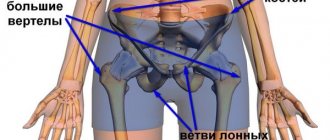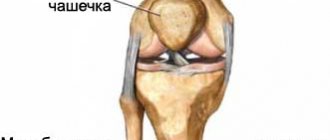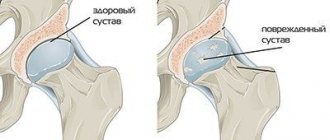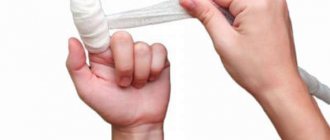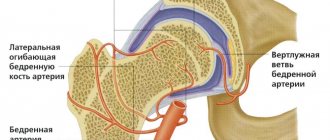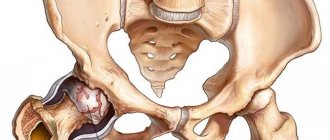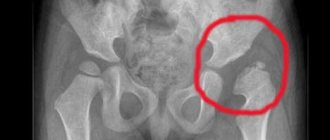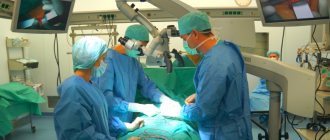The role of the hip joint in humans is difficult to overestimate, since it is the largest articular joint in the human body, which bears the main load when moving . This joint has a particularly complex structure, which includes many ligaments and muscle tissue. A fracture of the hip joint especially often affects older people, and treatment and a full recovery process require special care and a long period.
The main causes of hip fractures in the elderly
This joint can be damaged by the following situations:
- The main cause of injury is usually a fall to the side. When the load is created, destruction of the articular joint occurs.
- Road traffic accident.
- Industrial and domestic types of injuries.
- Damage received from animals or from interaction with other people, which can quite often cause cracks in the bones.
At the same time, the likelihood of earning such an injury greatly increases if the following predisposing factors are present:
- Menopause period.
- Prostatitis disease.
- Deviations such as osteoporosis.
- Excess body weight.
- Addictions (alcohol or drug addiction along with smoking).
- Various diseases of the joints and musculoskeletal system (for example, hernia, osteochondrosis or arthrosis).
- Pathologies in the vital systems of the body, for example, cirrhosis of the liver, impaired renal function, diabetes mellitus.
Features of the hip joint
The articular articulation of the pelvic and femoral bones has such a feature as the narrowness of the copetabula. When the head of the femur enters it, a very traumatic connection is formed. The most common diagnosis for this area of the musculoskeletal system in the event of injury is a “femoral neck fracture.” Damage usually occurs in the place of the bone where its head meets the base.
The reason for the widespread prevalence of this injury among elderly patients is the age-related characteristics of the bone tissue structure. Over the years, it becomes more porous and less durable. Thinning of the bone is caused by decalcification of the body. As a result, the consequences of injury can be prolonged immobility and complications.
The main symptoms of a hip fracture in a pensioner:
The list of main manifestations of this complex fracture may include:
- Very sharp pain in the affected area, which becomes more pronounced with movement or palpation.
- Some degree of stiffness of movement and inability to use the injured limb normally.
- Some deformation of the limb, which becomes significantly noticeable even without special instruments and diagnostic methods.
- The affected leg visually becomes somewhat shorter.
- Possible ligament ruptures.
- Inability to fully raise the leg (stuck heel syndrome).
- Crunching sound when pressure is applied to the affected area.
In addition, the consequences can manifest themselves in other forms, such as swelling and hematomas . In older people, such consequences appear very rarely, usually after a long period of time after injury.
When a hip joint is fractured, a pensioner may experience extremely strong and acute pain symptoms, which can only be extinguished with the help of special pain-relieving injections with strong pharmacological agents.
What types of fractures are there?
Any fracture causes pain and limited movement. The following types of injuries are distinguished:
- Damage to the femoral neck
- Injury to the femoral head
- Disorders in the greater trochanter area
The surgeon must determine the type of fracture based on the x-ray. Once the diagnosis is made, appropriate treatment is prescribed. In this case, the medical history is taken into account. The patient may experience the following symptoms:
- Local pain that gets worse with movement
- Increasing pain when tapping on the heel
- External rotation: the leg turns outward while walking
- Inability to keep the leg straight in the air. At the same time, the possibility of bending and extending the leg while lying down is preserved.
- Shortening of one of the legs. The difference in limb length can be from 2 to 4 cm.
If any of these symptoms appear after an injury, you should immediately consult a doctor.
The process of diagnosing a hip fracture in an elderly person
During the process of admitting a person to a hospital, a mandatory initial examination and examination is carried out, during which the patient is interviewed to identify symptoms, sensations and consequences. Based on the results of the current clinical picture, doctors can make a probable (presumptive) diagnosis . However, you can’t limit yourself to just these! To ensure that the circumstances are assessed correctly, doctors prescribe radiographic examinations. Even with the slightest suspicion of the presence of pathologies in the causes of damage, a CT scan is performed.
In cases where the diagnosis is confirmed, as well as the need for surgical intervention, the patient is referred for additional examination procedures:
- MRI.
- Ultrasound
- Cardiogram.
- Submission of general laboratory tests.
Also during the period of examination and diagnosis, an obligatory aspect is the accurate determination of the patient’s allergic reactions to any medications.
Features of rehabilitation of elderly patients
If the patient’s age is more than 50 years, the rehabilitation period will take from six months to two years. The cause of a subtrochanteric femoral fracture in old age is low bone strength, changes in the body associated with age, and the presence of chronic diseases. When caring for elderly patients, the following rules should be observed:
- To prevent bedsores and prevent congestion in the patient’s lungs, it is necessary to change the position of his body at least 7-10 times a day.
- An elderly patient should perform breathing exercises.
- To avoid necrosis of compressed tissues, you should place an inflatable ring under your lower back and a towel roll under your heels.
- Foods high in fiber help prevent constipation and normalize bowel movements in older patients.
- You can improve blood microcirculation and speed up regeneration processes in the hip area after injury with the help of anticoagulants.
Medicines are prescribed only by the attending physician, taking into account the absence of any contraindications for the elderly victim.
Types of treatment for elderly people with a hip fracture
There are two main methods used to remove debris: conservative and surgical. However, it must be noted that when using a non-surgical method, the effectiveness and efficiency of recovery is significantly reduced. Therefore, in this material we will not consider a conservative method of treating a hip fracture in the elderly, which can also be used when surgery is contraindicated.
Types of operations
In modern medicine, there are two main methods of treating fractures through surgery:
- Metal osteosynthesis. The purpose of this event is to fix all fragments and fragments of bones using metal fasteners. In cases of reliable fixation of fragments, the likelihood of correct and rapid fusion and recovery greatly increases.
- Endoprosthetics. This method involves partial or complete replacement of individual joint mechanisms. This technique is almost the most popular and widespread in the treatment of such injuries. This kind of surgery can significantly speed up the rehabilitation period for the full restoration of motor functions. However, this method also has some disadvantages. The main disadvantage is the significant degree of contact between the parts of the prosthesis and the acetabulum. As a result, the patient's hyaline layer becomes seriously thin.
The advantages of prosthetics include a minimal chance of injury during treatment, as well as a short period . The technique is perfect for patients of any age category. To increase the productivity of therapy during prosthetic procedures, polymerized types of cement are used. With their help, it is possible to securely fix the parts of the prosthesis, which makes it impossible for injuries during further use.
An extremely important factor is the timing of wearing a particular prosthesis, which depends on aspects of the patient’s lifestyle .
In cases where the patient prefers to maintain an active lifestyle, the prosthetic structures are subject to stress and wear out quickly, which requires replacement and intervention.
Treatment of femoral neck fractures: conservative and surgical
When the injury is uncomplicated, the fragments have not shifted and the general condition is not aggravated by chronic diseases, you can try to manage the patient using a conservative method.
Special gymnastics and drug treatment are prescribed, and after a while the patients become more active. Then the leg will have a rehabilitation period; recovery will take a lot of time. The period is long, up to a year.
Surgical treatment of a fracture is more often used. In relatively young patients (up to 60-65 years old), with fresh fractures, fragments are fixed with screws after closed reduction (matching) on an orthopedic table.
Schematic illustration and radiograph after osteosynthesis with screws
A high degree of reposition is achieved, but there is a risk of false joints. The rapid return of joint mobility and leg support is very important for the elderly.
Drugs to combat osteoporosis must be added.
Rehabilitation for a hip fracture in the elderly
It is extremely difficult to accurately predict the duration of the recovery period, since much depends on the age characteristics of the patient and the presence of other health problems . As a rule, such a period lasts six months. Particularly complex cases require rehabilitation lasting up to a year or more. In cases where the patient has a well-functioning immune system, recovery time can be significantly reduced.
Rehabilitation of elderly people with a hip fracture takes place in stages:
- Rehabilitation therapy should begin three days after applying a plaster cast . This stage involves massage procedures in the lumbar region. After about one week, similar massages are performed on the affected area.
- In cases where therapy progresses normally, the patient’s plaster is removed after two weeks. With proper supervision from the attending physician, simple movements begin: flexion and extension of the knee. At this stage, performing such exercises on your own is almost impossible. This opportunity will gradually appear after about a month.
- Two weeks later, a personal course of exercises is selected . The initial stage involves performing simple squats.
- At about the 4th month of rehabilitation therapy, it is recommended to switch to walking with the help of crutches . During such a movement, you must not put any weight on the affected limb.
Gradual increase in loads . With a properly designed and completed rehabilitation process after a fracture of the hip joint, an elderly person’s motor functions are completely restored in about 6 months. Of course, if we consider complex injuries, rehabilitation can take much longer.
Remember that a fracture of the hip joint in the elderly is a very complex injury that requires a special professional approach in diagnosis, determination, treatment and rehabilitation, which can be provided by certified employees of the Eden boarding house for the elderly with medical care in Moscow.
Rehabilitation procedure
Due to the nature of their age, older people require long-term recovery. Therefore, doctors recommend rehabilitation after a stroke, heart attack and other complex diseases. A femoral neck fracture also applies to them. During this period, the patient needs careful and professional care to ensure proper bone healing and return to active movement.
Of course, a familiar home environment and the absence of stress and anxiety are recommended for the patient. But not every family has the opportunity to provide the patient with adequate maintenance. For this purpose, we offer you the services of caregivers and nurses, and round-the-clock care will be provided in specialized care centers for the elderly.
“Home Care Center” offers you these services: for many years we have been providing reliable and effective support, providing a comfortable environment and quick recovery for our clients. Our range of services includes:
- 24-hour stay;
- organization of leisure;
- provision of nutritious and dietary nutrition;
- performing necessary medical procedures;
- maintaining hygiene;
- conservative treatment;
- massage and physiotherapy.
